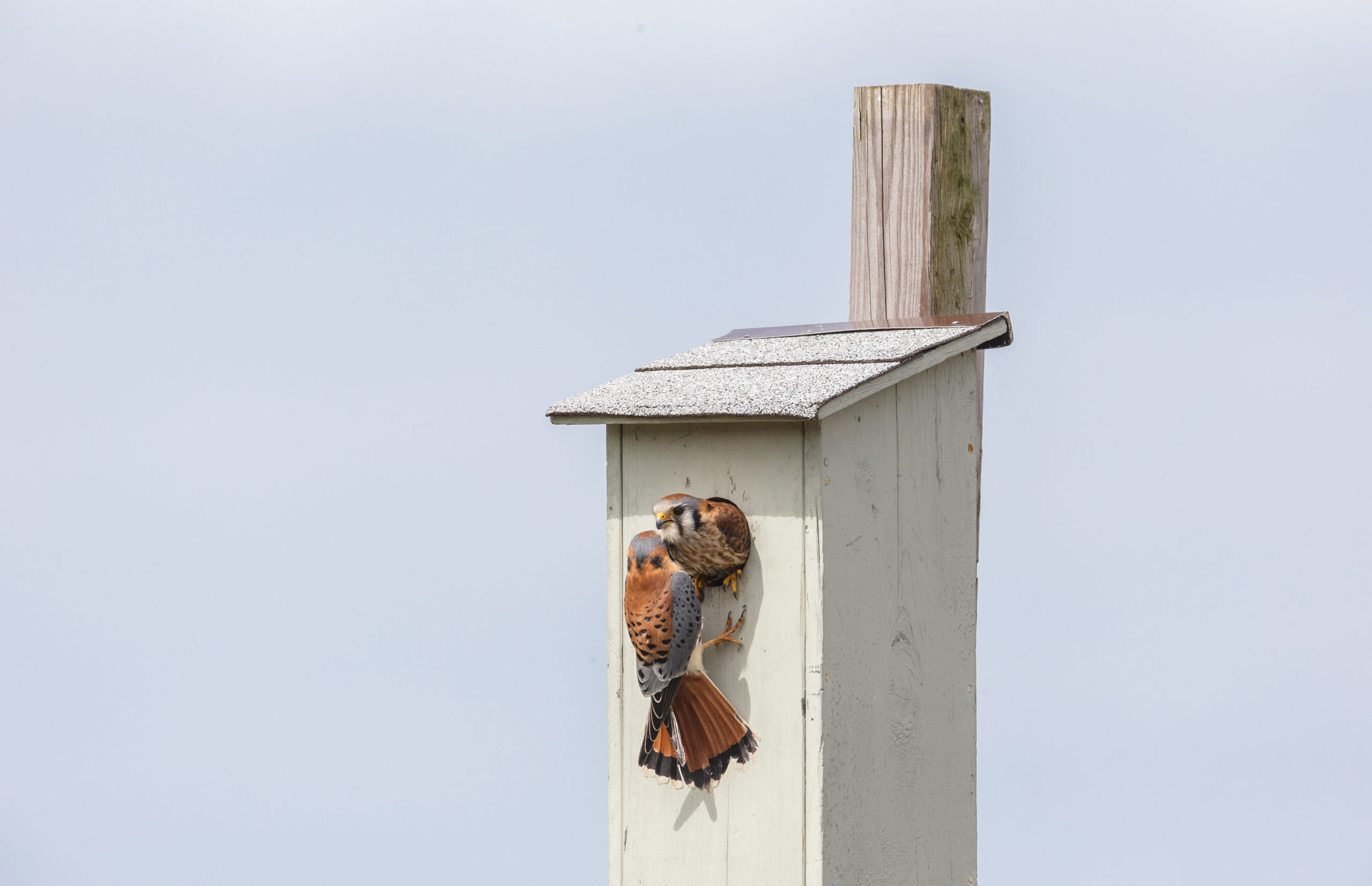Kestrels for Conservation
HFWA’s kestrel nest box monitoring program began in 2023 when volunteers and local farmers came together to build nest boxes for kestrels.
See the coverage by LocalNews8 about the program.
Interested in participating in the next box-building workshop? Visit our Events Page for updates and information about planned workshops!

Frequently Asked Questions about American Kestrels
What is a kestrel?
American Kestrels (also called sparrow hawks) are North America’s smallest falcon species (often red and grey colored) and are frequently visible from telephone lines and fence posts. They like to hunt on the edges of open meadows, pastures, and farmland, where they can sit and look for rodents, small birds, and grasshoppers. Some kestrels migrate during winter while others do not. In Idaho, kestrels set up breeding territories in early spring and will begin nesting near the beginning of April. Kestrels nest in tree cavities and hunt within 1 km of their nests and rear clutches of 4-6 chicks. The chicks hatch at the start of June, when insects and rodents are becoming abundant. 30 days after hatching, the chicks fledge by falling out of the nest and hiding in cover until they’re strong enough to fly.
Why care about kestrels?
The presence of kestrels and other raptors tend to discourage flocks of starlings and European sparrows. Research has found that densities of small birds are lower in areas with breeding kestrels. Small birds tend to avoid nesting in close proximity to kestrel nests. Because kestrels cannot carve out their own nest cavities, they won’t set up a breeding territory without a nesting cavity nearby, even if there are lots of prey around.
These facts put together make kestrels a good friend to farmers. Kestrels both eat and scare away common pests for farmers. In return, there are a few simple ways farmers can help the kestrels. By placing nesting boxes in favorable locations, farmers can almost instantly create breeding habitat for kestrels. We all know there isn’t a limit to the songbirds, rodents, and grasshoppers that pastures and farmland encourage. The only thing that may be stopping a kestrel family from moving in is an appropriate cavity to nest in.

What does a nest box look like?
Nest boxes are approx. 10” x 10” x 18”. The front has a 3×4” vertical hole and an inside perch. Well-designed kestrel nest box plans are available from kestrel.peregrinefund.org. Materials or completed boxes are available from Henrys Fork Wildlife Alliance. Some people like to add shingles or paint the boxes with a light color or polyurethane, but these additions are not necessary. Important aspects of a nest box include ventilation near the top, a water-tight roof, and a couple holes in the bottom for any moisture to drain.
Where to place a nest box?
Kestrels can adapt to many different habitats, from open farmland, to sparse woodlands. Nest boxes can be placed on the side of a tree, pole, or building. Kestrels begin scouting for next year’s nest location in the fall so it may take a year or more for a pair to move in. Once you decide you want to put up a kestrel nest box, picking a good location will increase your odds of attracting kestrels. Try to check off as many of these characteristics as you can to encourage the parents to come back year after year:
- Near an area with open fields or sparse woodland and locations for perching (telephone poles, trees, fences, etc.)
- 8-20ft off the ground (shorter is safer for monitoring)
- A quarter-mile apart
- In a place that will get partial shade during hot summer afternoons
- Facing away or sheltered from the prevailing wind
- Not above a yard with a dog – don’t want the fledglings to become a snack!
- Not over a cement pad or an area that sees heavy traffic or machinery.

How do I care for a nest box?
Our kestrel box plans have a side opening that can be used to clean the box or to monitor the chicks. A couple inches of wood chips, wood shavings, or straw are the best bedding materials and should be replaced in the fall or early spring. During the nesting season (April-June), monitor the nest box occasionally to make sure no starlings take up residence. However, you should avoid opening the box during nesting season without proper training to avoid disturbing the parents, especially during incubation when they are most likely to abandon the nest.
Want help monitoring your box?
In addition to providing materials to build nest boxes, Henrys Fork Wildlife Alliance is happy to provide assistance with monitoring and upkeep. We will clean the boxes each fall and remove unwanted starling nests during the nesting season. We will also monitor the success of any kestrels in your nest box. Monitoring will only require a short visit every 7-10 days through the month of June. More frequent visits could cause the parents to abandon the nest.
Sign up to become a monitor
Why does HFWA care?
We believe conservation is most successful long-term when local citizens feel involved and have ownership. Henrys Fork Wildlife Alliance is dedicated to helping landowners connect to the rich wildlife we all value here in Idaho. We offer simple opportunities, funds, or knowledge needed to give volunteers and residents the satisfaction of doing something good for wildlife, no matter how small.

